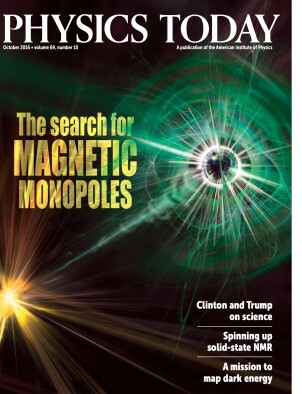Atomic and Molecular Spectroscopy: Basic Concepts and Applications
DOI: 10.1063/PT.3.3333
In her preface to Atomic and Molecular Spectroscopy: Basic Concepts and Applications, Rita Kakkar writes that the book is primarily intended for graduate and advanced undergraduate students who have already taken a course in quantum mechanics and know how to apply elementary molecular point-group representation theory. Her text covers the basics of light–matter interactions; electronic spectroscopy of atoms; and rotational, vibrational, and electronic spectroscopies of diatomic and small polyatomic molecules. Raman spectroscopy, vibrational and rotational, receives its own chapter. That separation is common, but I prefer to integrate Raman with other absorption and emission spectroscopies. The book does not consider magnetic resonance spectroscopies or even the influence of nuclear moments on spectra.

The most attractive features of Atomic and Molecular Spectroscopy are that each chapter has many fully worked-out problems and each concludes with numerous exercises; the book includes 257 exercises in total. Mathematical derivations are presented in great detail, so even the weakest students should be able to follow them.
The cost of those features, however, is that the book treats most topics at a lower level of detail than comparable texts, such as Peter Bernath’s Spectra of Atoms and Molecules (3rd edition, Oxford University Press, 2015). The organization and range of topics in the Kakkar and Bernath books are similar, but Kakkar’s is less thorough and quantitative. For example, the Kakkar text does not present a mathematical statement of the Born–Oppenheimer approximation, the most important principle in molecular spectroscopy; in fact, its qualitative statement of the principle is potentially misleading. Furthermore, the book does not cover the traditional effective model used to justify a single term for spin–orbit coupling, nor does it explain why the coupling grows rapidly with atomic number. The discussion of rotational spectroscopy does not quantitatively treat asymmetric top molecules, in which all three principal moments of inertia differ.
Atomic and Molecular Spectroscopy covers only traditional, well-established topics. I did not find a single subject that has not been presented in texts more than 50 years old. Completely absent are coherent spectroscopies, the optical Bloch equations, nonlinear optics and multiphoton spectroscopies, multiresonance and time-resolved spectroscopies, studies of intramolecular and intermolecular dynamics, ions and radicals, spectroscopy of weakly bound complexes, and almost all the other topics that feature in modern molecular-spectroscopy research. I recognize from my own teaching that only a small number of such topics can be shoehorned into a one-semester course, but I believe ignoring all modern research is a great disservice. Most spectroscopy papers these days include a comparison of experimental results with predictions from quantum chemistry, but Kakkar’s text includes no such comparisons.
Unfortunately, the book has several other weaknesses. First, it frequently compares quantities that have different units or talks about dimensional quantities being large or small with no explicit reference. Second, it contains many false statements. Some of those could be typographical errors or oversimplifications, but most cannot be so readily dismissed. Third, although the book includes a two-page bibliography, it does not include in-text references, an omission that blocks the path of the curious student eager to learn more. In addition, the text is poorly copyedited, and it includes many low-quality graphs and figures, several of which are copied from Colin N. Banwell’s Fundamentals of Molecular Spectroscopy (McGraw-Hill, 1983).
I cannot recommend Atomic and Molecular Spectroscopy, on its own, to anyone, though it could be useful as a companion text for weaker students taking a course that is using a higher-level primary text such as Bernath’s. More’s the pity, as students would benefit from a truly modern molecular spectroscopy textbook that prepares them to read the current literature and work on modern research projects. At the moment, no such book exists.
More about the Authors
Kevin Lehmann is the William R. Kenan Jr Professor of Chemistry and Physics at the University of Virginia in Charlottesville; he has taught spectroscopy for more than two decades. His research focuses on high-resolution laser spectroscopy, including applications to environmental and biomedical monitoring and to molecular dynamics.
Kevin Lehmann. University of Virginia, Charlottesville.
